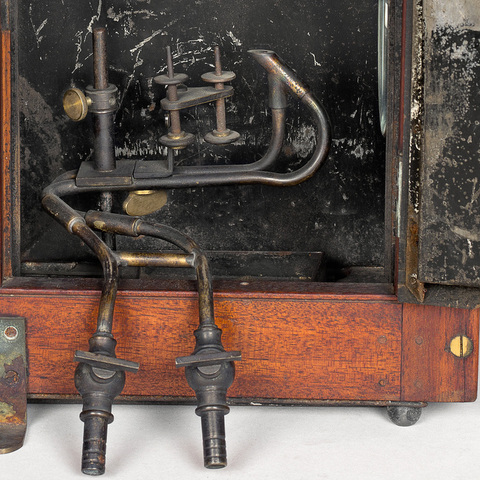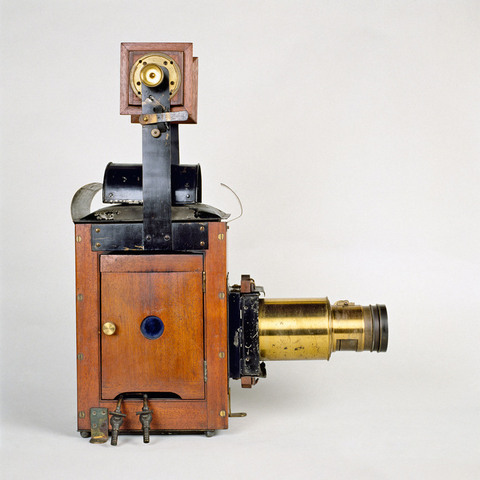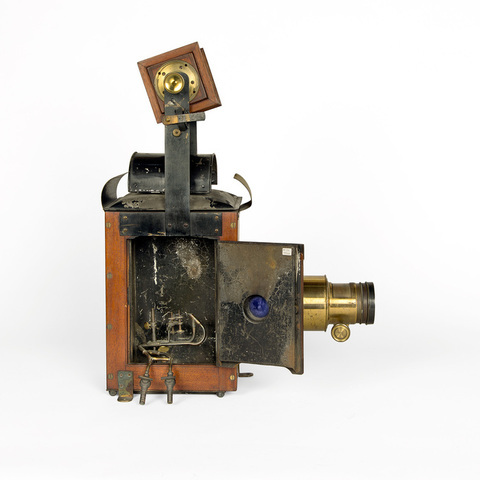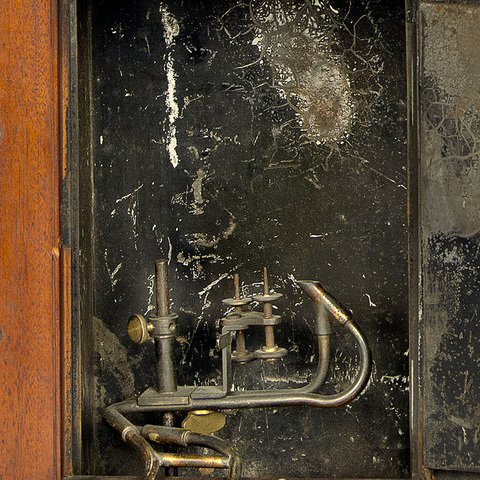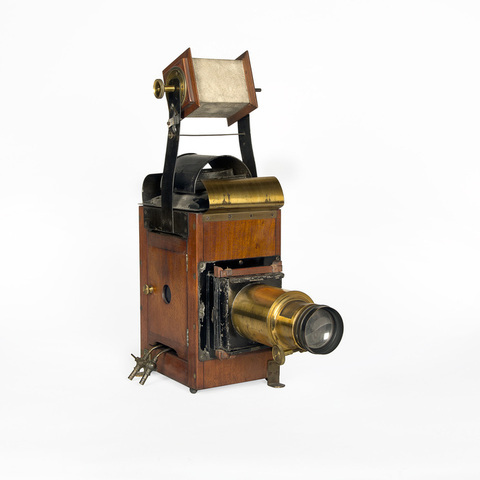Lanterne de projection
Fiche détaillée
Type de l'appareil
pour vues successives montées sur bande et cadres, passant une à une verticalement au foyer de l'objectif au moyen d'un rectangle rotatif en bois et feutre (11,5 x 15 cm) qui est monté sur axe et entraîne la bande, celle-ci fait le tour de l'appareil dans le sens vertical ; lampe oxhydrique et à bâton de chaux ; cheminée ; passe-vue vertical ; tube optique à crémaillère ; condensateur
Auteurs
Thomson John
[Londres]
Beechy Reverend Canon
Londres
Fabricants
John Thomson
[Londres]
Utilisateurs
Thomson John
[Londres]
Beechy Reverend Canon
Londres
Distributeurs
Informations non disponibles
Sujet du modèle
Informations non disponibles
Objectif
condensateur deux lentilles 11,5 cm Ø ; objectif 7 cm Ø
Taille de l'objet
Ouvert :
Informations non disponibles
Fermé :
Longueur : 51 cm
Largeur : 24.5 cm
Hauteur : 65.5 cm
Diamètre :
Informations non disponibles
Taille de la boîte de transport
Informations non disponibles
Remarques
La lanterne était fixée à l'origine sur une caisse en bois. Les vues montées une à une sur cadre et sur bande passaient à l'intérieur de cette boîte.
"Fig. 11 introduces to public notice for the first time a lantern designed by the author for his own use. It possesses certain advantages, and is specially adapted for lectures where the subjects follow each other in an unbroken series. Mistakes arising from the insertion of a wrong slide, or an inverted subject, are apt to mar an evening's entertainment. But, as will be shown, errors of this nature are altogether avoided, and, by a simple mechanical arrangement, the slides present themselves in perfect order, and at their allotted times. The instrument is fixed to the top of the packing-case by the screws ; the lid of the case serves to elevate or depress the lantern, which may be fixed in position at any angle. Reared above the chimney are two metal uprights, secured to the sides of the lantern. These carry at their apex a wooden cube covered with fine leather ; each side of this cube corresponds with the size of the slides. But, by the aid of strong ribbon binding, the slides are so united as to form a flexible band which traverses the cube and descends into the case through slots. The cube turns on its axis, to which is attached a milled head. The band is made so that the slides can be detached, and replaced by a new series at will. The advantages of this simple arrangement are so obvious, as hardly to require further comment. The operator has only to turn the milled head of the cube in order to bring his subjects, one after the other, into position. This system might be applied also to the bi-unial apparatus, where dissolving views are required. The heat from the chimney is never so intense as to interfere, in any way, with the slides, while it clears them of surface-moisture, by which they might be obscured during cold weather" (John Thomson, "The Magic Lantern", Science for All, Londres, 1890, pp. 208-214).
"In 1860 the Reverend Canon Beechy invented a peculiar type of lantern in his endeavour to show life like movement upon the screen. This was sold on the market as Thomson's Lantern, through being used by Mr. John Thomson, F.R.G.S. in his numerous lectures. The Lantern was of rather tall dimensions and had two arms at the top, which carried a four square faced revolving drum mounted upon a central spindle, one end of which was cranked to form a handle. The slides were mounted in holders upon an endless chain band, and upon revolving the top drum the slides were dropped in rapid sequence behind the lens and thus projected upon the screen. This lantern was used by many of the early moving picture inventors for experimental purposes, and one of the keenest users of this type of machine was M. Eyre Donisthorpe" (Will Day, 25 000 Years to Trap a Shadow, tapuscrit, archives Cinémathèque française).
Bibliographie
John Thomson, "The Magic Lantern", Science for All, Londres, 1890, pp. 208-214.
Will Day, 25 000 Years to Trap a Shadow, tapuscrit, archives Cinémathèque française.
